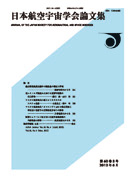All issues

Volume 35, Issue 400
Displaying 1-6 of 6 articles from this issue
- |<
- <
- 1
- >
- >|
-
Toward Mach 4-25 FlightNobuo CHINZEI, Goro MASUYA1987Volume 35Issue 400 Pages 241-252
Published: May 05, 1987
Released on J-STAGE: December 16, 2010
JOURNAL FREE ACCESSDownload PDF (22005K) -
Takashi TANI, Norio ARAI, Koetsu TAKEHANA, Hideo SEKINE, Naoki HIROSE1987Volume 35Issue 400 Pages 253-259
Published: May 05, 1987
Released on J-STAGE: December 16, 2010
JOURNAL FREE ACCESSThis article investigates both experimentally and numerically the complicated flow around the blunted cone of semi-apex angle 20-45 degrees at Mach number 1.4-3.0. Especially, emphasized is the structure of subsonic flow region on the cone surface, that is caused by the transition from the over-expanded flow at the nose to the re-compression on the cone. Both results are in good agreement with each other. Consequently, it is shown that the numerical analysis of inviscid flow is very practical for such a complicated flow.View full abstractDownload PDF (8570K) -
Kyo Han KIM, Teruo KISHI, Megumi SUNAKAWA, Shiro KOHARA1987Volume 35Issue 400 Pages 260-265
Published: May 05, 1987
Released on J-STAGE: December 16, 2010
JOURNAL FREE ACCESSBased on the results of tensile and fracture toughness tests and AE detecting method, mechanical properties of Al-Li alloy are examined. Specimens tested were heat-treated in three different conditions, i. e., T42, T6, and T8 ones. The tensile characteristics and fracture toughness of the alloy are discussed in detail. Any effect of cold-rolling on the fracture toughness could not be founded. Fracture surface of T42 specimens was that of transgranular, while those of T6 and T8 specimens were entirely intergranular and secondary cracks perpendicular to crack plane were observed. The fracture mechanism of this alloy is proposed according to the AE activities during the fracture toughness test and the crack jump size calculated using the compliance method. The fracture toughness K1C is also calculated by a ductile fracture model, which shows a good agreement with experimental results.View full abstractDownload PDF (7504K) -
Keiji KOMATSU, Syuji ONO, Junichiro SHIMIZU, Ryuichi NAGASHIMA, Shinic ...1987Volume 35Issue 400 Pages 266-269
Published: May 05, 1987
Released on J-STAGE: December 16, 2010
JOURNAL FREE ACCESSTwo experiments are carried out to investigate the dynamic behavior of the liquid partially filled in spherical tanks of a spinning satellite. One is the simulation test at the spin up phase of the rocket. The other is the sloshing test to analyze the propellant sloshing effects on the satellite attitude control. These experiments are specially set for the Engineering Test Satellite V which has two spherical tanks 37% filled with hydrazine, but the results obtained can be applicable to the other problems of the liquid dynamics in spherical tanks.View full abstractDownload PDF (6685K) -
An Experimental Investigation of Aerodynamic Drag of Peripheral Jet GEM with a Forward-Facing IntakeFumiharu OTAGIRI, Shigenori ANDO, Hironari NOHARA1987Volume 35Issue 400 Pages 270-275
Published: May 05, 1987
Released on J-STAGE: December 16, 2010
JOURNAL FREE ACCESSThe “interference thrust” suggested by Ando et al. has been confirmed by series of experimental investigations in our laboratory. However the models used in those experiments are considerably simplified ones in comparison with existing GEMs in practical operation. The purpose of the present work is to complete series of experimental investigations by using more practical model configuration. In order to achieve both satisfactory separation of the parasite drag from the momentum drag and a good intake efficiency, a forward-facing intake is adopted. The results of this experiment present a better proof of “interference thrust”.View full abstractDownload PDF (10200K) -
1987Volume 35Issue 400 Pages 276
Published: 1987
Released on J-STAGE: March 02, 2011
JOURNAL FREE ACCESSDownload PDF (53K)
- |<
- <
- 1
- >
- >|